1995 GMC SIERRA stop start
[x] Cancel search: stop startPage 191 of 488
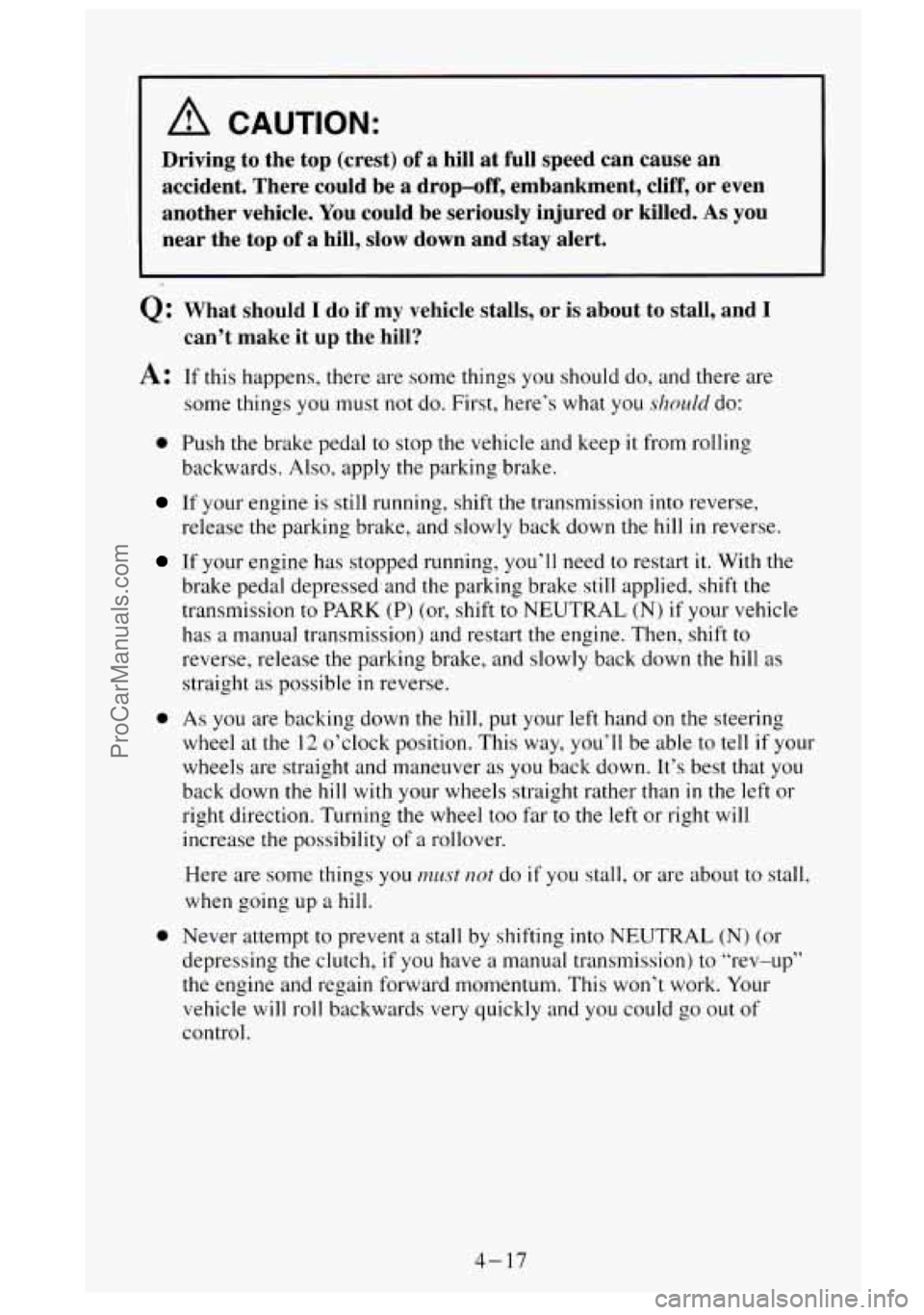
A CAUTION:
Driving to the top (crest) of a hill at full speed can cause an
accident. There could be a drop-off, embankment, cliff, or even
another vehicle. You could be seriously injured
or killed. As you
near the top
of a hill, slow down and stay alert.
Q: What should I do if my vehicle stalls, or is about to stall, and I
A: If this happens, there are some things you should do, and there are
some things you must not do. First, here’s what you
shoclld do:
can’t make it up the hill?
0 Push the brake pedal to stop the vehicle and keep it from rolling
backwards. Also, apply the parking brake.
If your engine is still running, shift the transmission into reverse,
release the parking brake, and slowly back down the
hill in reverse.
If your engine has stopped running, you’ll need to restart it. With the
brake pedal depressed and the parking brake still applied, shift the
transmission to PARK (P) (or, shift to NEUTRAL
(N) if your vehicle
has a manual transmission) and restart the engine. Then, shift
to
reverse, release the parking brake, and slowly back down the hill as
straight
as possible in reverse.
0 As you are backing down the hill, put your left hand on the steering
wheel at the
12 o’clock position. This way, you’ll be able to tell if your
wheels are straight and maneuver
as you back down. It’s best that you
back down the hill with your wheels straight rather than in the left or
right direction. Turning the
wheel too far to the left or right will
increase the possibility
of a rollover.
Here are some things you
must mt do if you stall, or are about to stall,
when going
up a hill.
0 Never attempt to prevent a stall by shifting into NEUTRAL (N) (or
depressing the clutch,
if you have a manual transmission) to ”rev-up”
the engine and regain forward momentum. This won’t work. Your
vehicle will roll backwards very quickly and
you could go out of
control.
4-’17
ProCarManuals.com
Page 193 of 488
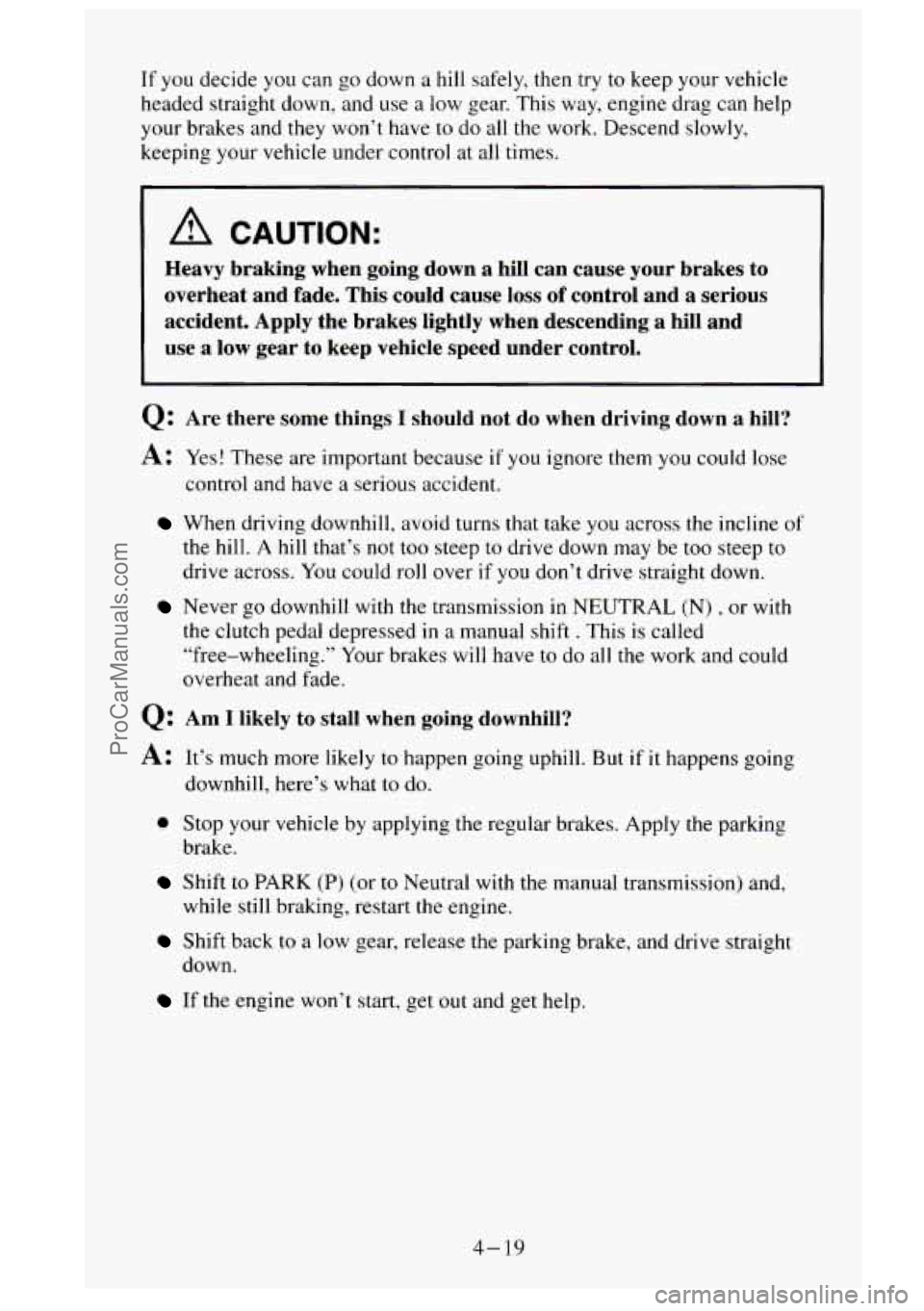
If you decide you can go down a hill safely, then try to keep your vehicle
headed straight down, and use a low gear. This way, engine drag can help
your brakes and they won’t have to do all
the work. Descend slowly,
keeping your vehicle under control at all times.
A CAUTION:
Heavy braking when going down a hill can cause your brakes to
overheat and fade. This could cause
loss of control and a serious
accident. Apply the brakes lightly when descending
a hill and
use a low gear to keep vehicle speed under control.
Q: Are there some things I should not do when driving down a hill?
A: Yes! These are important because if you ignore them you could lose
control and have a serious accident.
When driving downhill, avoid turns that take you across the incline of
the hill. A hill that’s not too steep to drive down may be too steep to
drive across.
You could roll over if you don’t drive straight down.
Never go downhill with the transmission in NEUTRAL (N) , or with
the clutch pedal depressed in a manual shift
. This is called
“free-wheeling.” Your brakes will have to do all the work and could
overheat and fade.
Q: Am I likely to stall when going downhill?
A: It’s much more likely to happen going uphill. But if it happens going
downhill, here’s what
to do.
0 Stop your vehicle by applying the regular brakes. Apply the parking
brake.
Shift to PARK (P) (or to Neutral with the manual transmission) and,
while still braking, restart the engine.
down.
Shift back to a low gear, release the parking brake, and drive straight
If the engine won’t start, get out and get help.
4- 19
ProCarManuals.com
Page 195 of 488
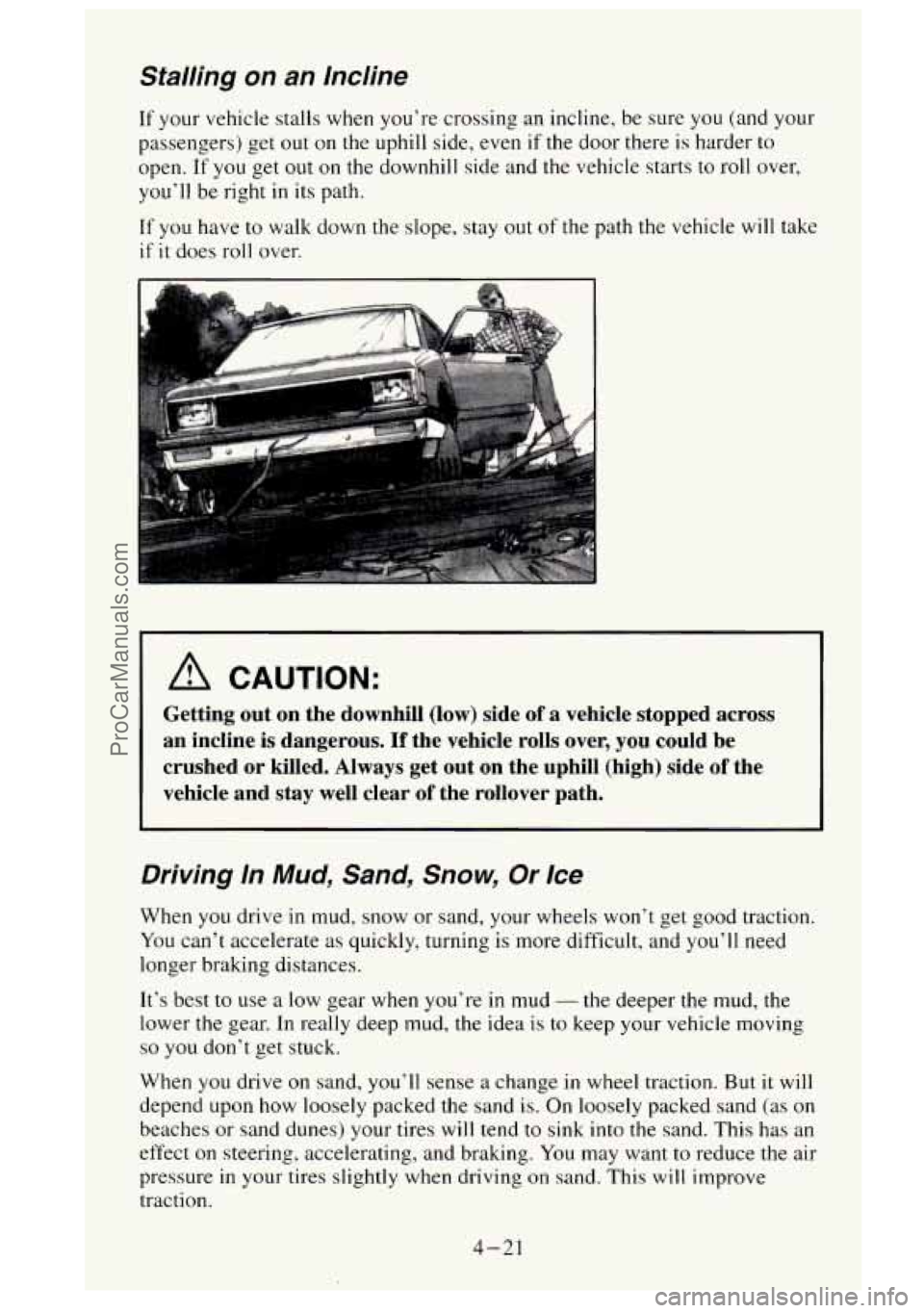
Stalling on an lncline
If your vehicle stalls when you’re crossing an incline, be sure you (and your
passengers) get out on the uphill side,
even if the door there is harder to
open.
If you get out on the downhill side and the vehicle starts to roll over,
you’ll be right in its path.
If you have to walk down the slope, stay out of the path the vehicle will take
if it does roll over.
1 A CAUTION:
Getting out on the downhill (low) side of a vehicle stopped across
an incline is dangerous.
If the vehicle rolls over, you could be
crushed or killed. Always get out on the uphill (high) side of the
vehicle and stay well clear
of the rollover path.
Driving In Mud, Sand, Snow, Or Ice
When you drive in mud, snow or sand, your wheels won’t get good traction.
You can’t accelerate
as quickly, turning is more difficult, and you’ll need
longer braking distances.
It’s best
to use a low gear when you’re in mud - the deeper the mud, the
lower
the gear. In really deep mud, the idea is to keep your vehicle moving
so you don’t get stuck.
When you drive on sand, you‘ll sense
a change in wheel traction. But it will
depend upon how loosely packed the sand
is. On loosely packed sand (as on
beaches or sand dunes) your tires will tend to sink into the sand. This has an
effect on steering, accelerating, and braking.
You may want to reduce the air
pressure in your tires slightly when driving
on sand. This will improve
traction.
4-21
ProCarManuals.com
Page 196 of 488
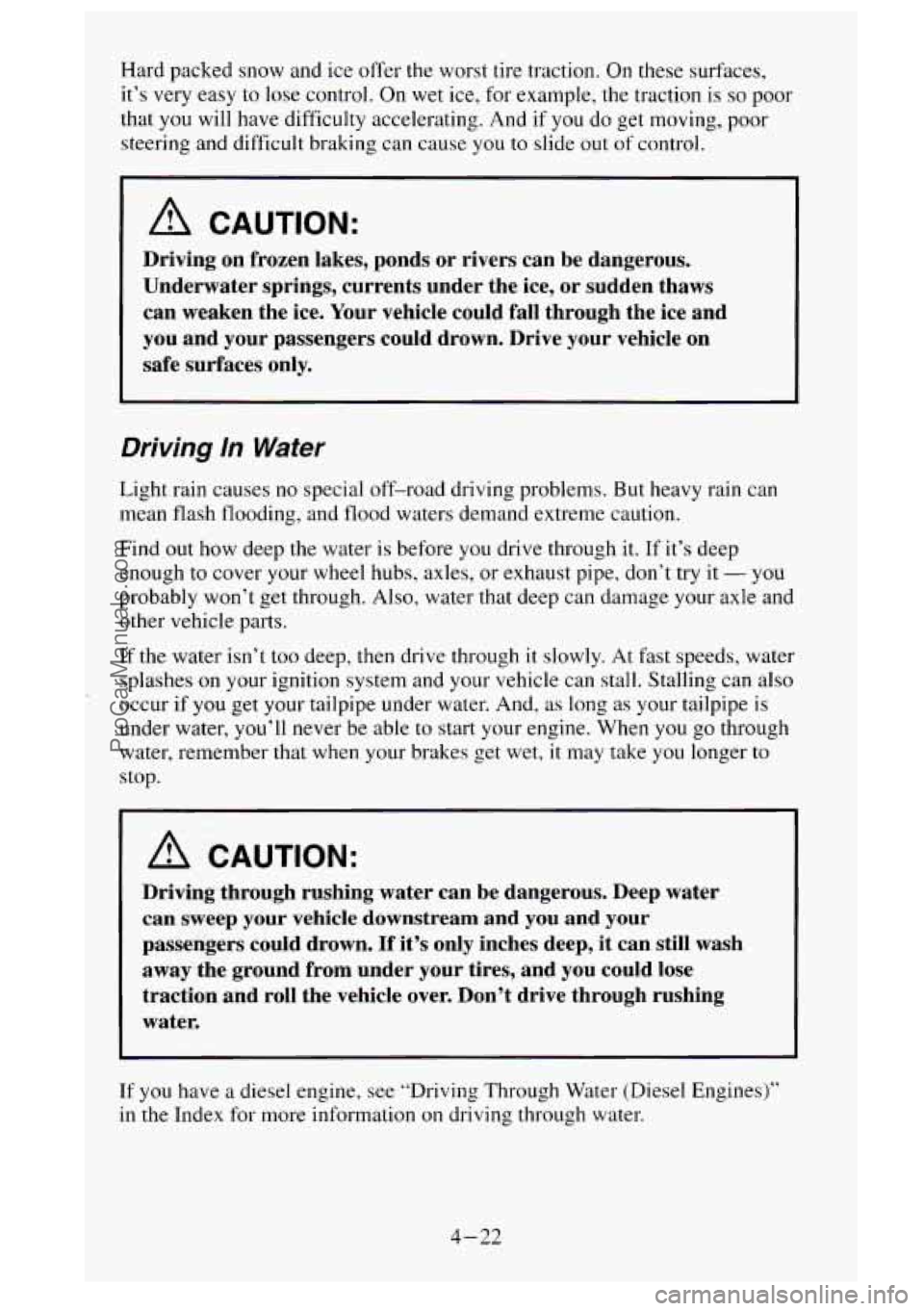
Hard packed snow and ice offer the worst tire traction. On these surfaces,
it’s very easy
to lose control. On wet ice, for example, the traction is so poor
that you will have difficulty accelerating. And if you do get moving, poor
steering and difficult braking can cause you to slide
out of control.
A CAUTION:
Driving on frozen lakes, ponds or rivers can be dangerous.
Underwater springs, currents under the ice, or sudden thaws
can weaken the ice. Your vehicle could fall through the ice and
you and your passengers could drown. Drive your vehicle on
safe surfaces only.
Driving In Water
Light rain causes no special off-road driving problems. But heavy rain can
mean flash flooding, and flood waters demand extreme caution.
Find out how deep the water is before
you drive through it. If it’s deep
enough to cover your wheel hubs, axles, or exhaust pipe, don’t try
it - you
probably won’t get through. Also, water that deep can darnage your axle and
other vehicle parts.
If the water isn’t too deep, then drive through
it slowly. At fast speeds, water
splashes
on your ignition system and your vehicle can stall. Stalling can also
occur if you get your tailpipe under water. And, as long as your tailpipe is
under water, you’ll never be able to start your engine. When
you go through
water, remember that when your brakes get wet,
it may take you longer to
stop.
A CAUTION:
Driving through rushing water can be dangerous. Deep water
can sweep your vehicle downstream and you and your
passengers could drown.
If it’s only inches deep, it can still wash
away the ground
from under your tires, and you could lose
l traction and roll the vehicle over. Don’t drive through rushing
water.
If you have a diesel engme, see “Driving Through Water (Diesel Engines)”
in the Index for more information on driving through water.
4-22
ProCarManuals.com
Page 199 of 488
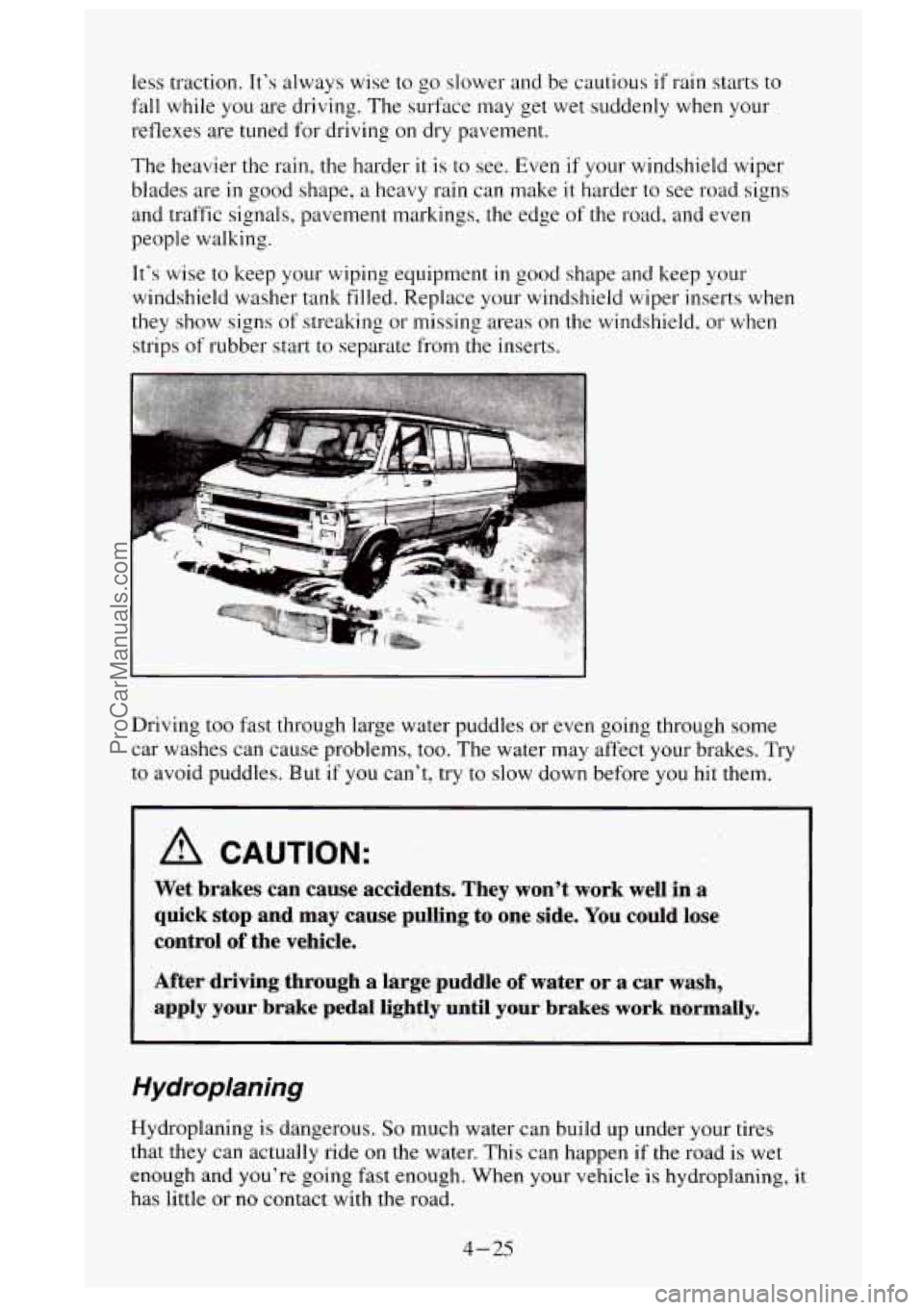
less traction. It‘s always wise to go slower and be cautious if rain starts to
fall while you are driving. The surface may get wet suddenly when your
reflexes are tuned for driving on dry pavement.
The heavier the rain, the harder
it is to see. Even if your windshield wiper
blades are
in good shape, a heavy rain can make it harder to see road signs
and traffic signals, pavement markings, the edge of the road, and even
people walking.
It‘s wise to keep
your wiping equipment in good shape and keep your
windshield washer tank filled. Replace your windshield wiper inserts when
they show signs
of streaking or missing areas on the windshield, or when
strips
of rubber start to separate from the inserts.
Driving too fast through large water puddles or even going through
some
car washes can cause problems, too. The water may affect your brakes. Try
to avoid puddles. But
if you can’t, try to slow down before you hit them.
A CAUTION:
Wet brakes can cause accidents. They won’t work well in a
quick stop and may cause pulling to one side. You could lose
control
of the vehicle.
After driving through a large puddle of water or a car wash,
apply your brake pedal lightly until your brakes work normally.
Hydroplaning
Hydroplaning is dangerous. So much water can build up under your tires
that they can actually ride on the water. This can happen
if the road is wet
enough and you’re going fast enough. When your vehicle is hydroplaning,
it
has little or no contact with the road.
4-25
ProCarManuals.com
Page 202 of 488
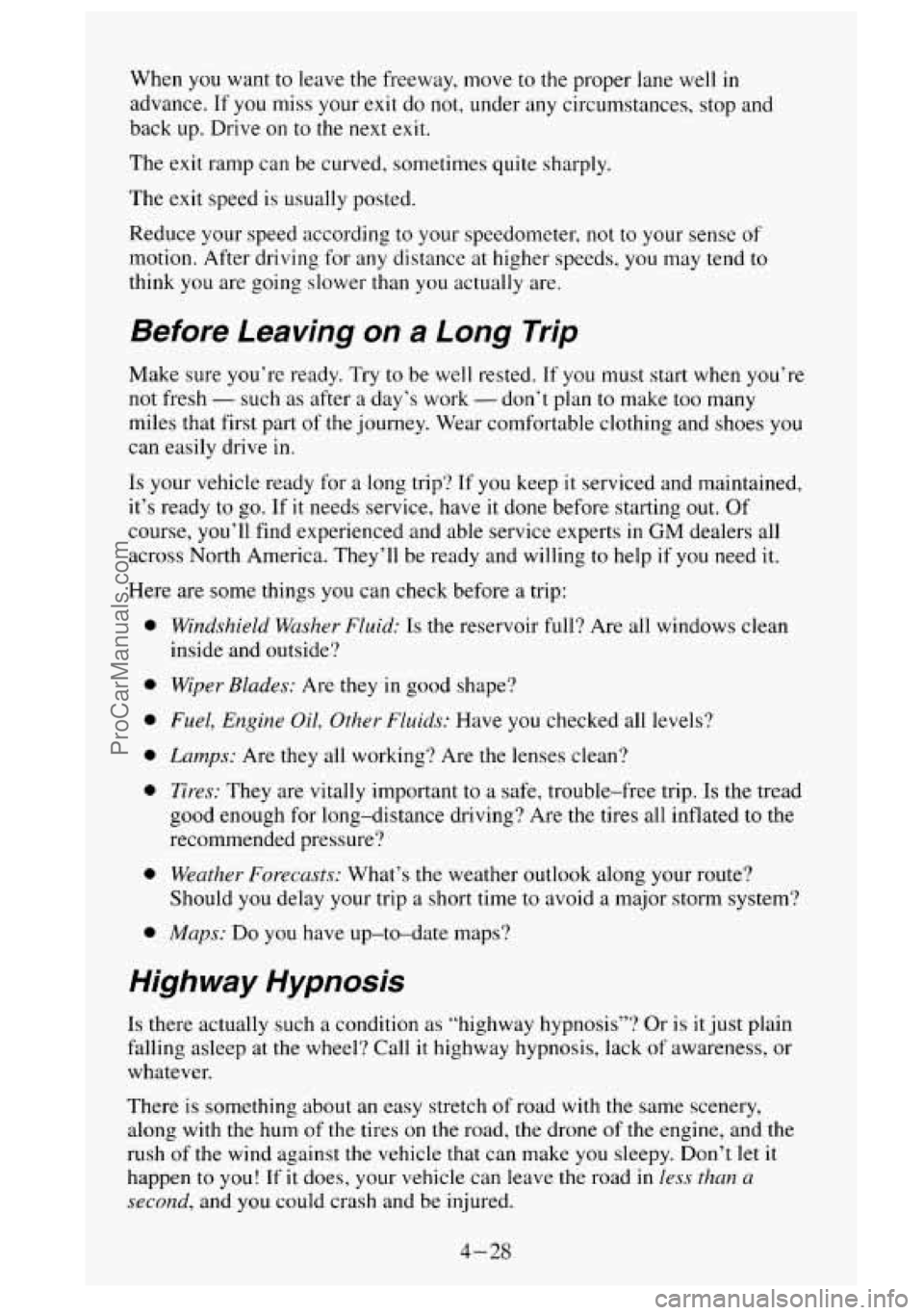
When you want to leave the freeway, move to the proper lane well in
advance. If
you miss your exit do not, under any circumstances, stop and
back up. Drive on
to the next exit.
The exit ramp can be curved, sometimes quite sharply.
The
exit speed is usually posted.
Reduce your speed according to your speedometer, not to your sense
of
motion. After driving for any distance at higher speeds, you may tend to
think you are going slower than you actually are.
Before Leaving on a Long Trip
Make sure you’re ready. Try to be well rested. If you must start when you’re
not fresh
- such as after a day’s work - don’t plan to make too many
miles that first part
of the journey. Wear comfortable clothing and shoes you
can easily drive
in.
Is your vehicle ready for a long trip‘? If you keep it serviced and maintained,
it’s ready to go.
If it needs service, have it done before starting out. Of
course, you’ll find experienced and able service experts
in GM dealers all
across North America. They’ll be ready and willing to help if you need it.
Here are some things you can check before a trip:
0
0
0
0
0
a
0
Windshield Washer Fluid: Is the reservoir full? Are all windows clean
inside and outside?
Wiper Blades: Are they in good shape?
FueZ, Engine Oil, Other Fluids: Have you checked all levels?
Lamps: Are they all working? Are the lenses clean?
Tires: They are vitally important to a safe, trouble-free trip. Is the tread
good enough for long-distance driving? Are
the tires all inflated to the
recommended pressure?
Weather Forecasts: What’s the weather outlook along your route?
Should
you delay your trip a short time to avoid a major storm system?
Maps: Do you have up-to-date maps?
Highway Hypnosis
Is there actually such a condition as “highway hypnosis”? Or is it just plain
falling asleep at the wheel? Call it highway hypnosis, lack of awareness, or
whatever.
There
is something about an easy stretch of road with the same scenery,
along with the
hum of the tires on the road, the drone of the engine, and the
rush
of the wind against the vehicle that can make you sleepy. Don’t let it
happen
to you! If it does, your vehicle can leave the road in less than a
second, and you could crash and be injured.
4-28
ProCarManuals.com
Page 221 of 488
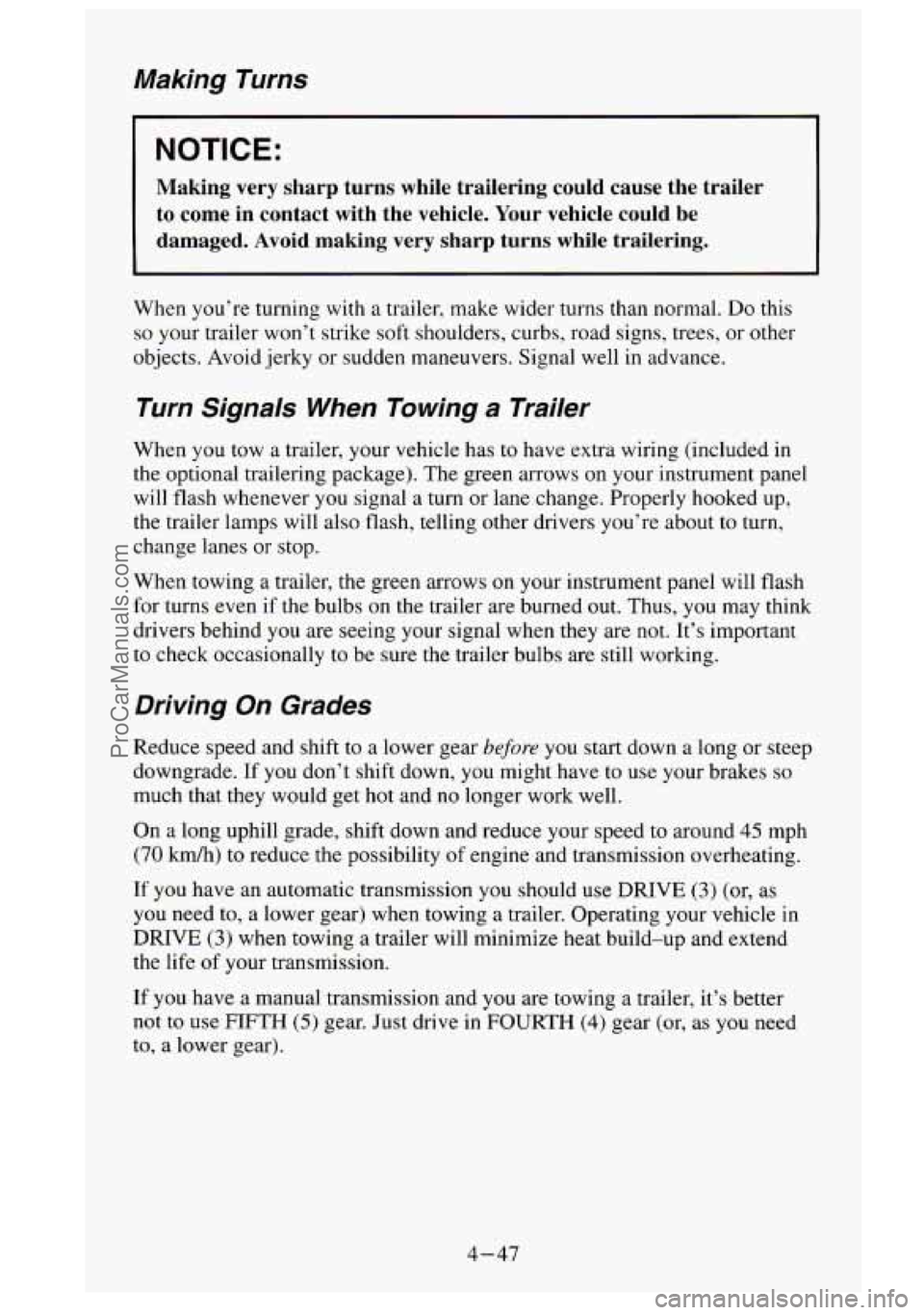
Making Turns
I NOTICE:
Making very sharp turns while trailering could cause the traile\
r to come in contact with the vehicle. Your vehicle could be
damaged. Avoid making very sharp turns while trailering.
When you’re turning with a trailer, make wider turns than normal. Do this
so your trailer won’t strike soft shoulders, curbs, road signs, trees, or other
objects. Avoid jerky or sudden maneuvers. Signal well in advance.
Turn Signals When Towing a Trailer
When you tow a trailer, your vehicle has to have extra wiring (included in
the optional trailering package). The green arrows
on your instrument panel
will flash whenever
you signal a turn or lane change. Properly hooked up,
the trailer lamps will also flash, telling other drivers you’re about to turn,
change lanes or stop.
When towing a trailer, the green arrows on your instrument panel will flash
for
turns even if the bulbs on the trailer are burned out. Thus, you may think
drivers behind
you are seeing your signal when they are not. It’s important
to check occasionally to be sure the trailer bulbs are still working.
Driving On Grades
Reduce speed and shift to a lower gear before you start down a long or steep
downgrade. If
you don’t shift down, you might have to use your brakes so
much that they would get hot and no longer work well.
On
a long uphill grade, shift down and reduce your speed to around 45 mph
(70 kmh) to reduce the possibility of engine and transmission overheating.
If you have an automatic transmission
you should use DRIVE (3) (or, as
you need to, a lower gear) when towing a trailer. Operating your vehicle in
DRIVE (3) when towing a trailer will minimize heat build-up and extend
the life
of your transmission.
If you have a manual transmission and
you are towing a trailer, it’s better
not to use FIFTH (5) gear. Just drive in FOURTH (4) gear (or, as you need
to, a lower gear).
4-47
ProCarManuals.com
Page 223 of 488
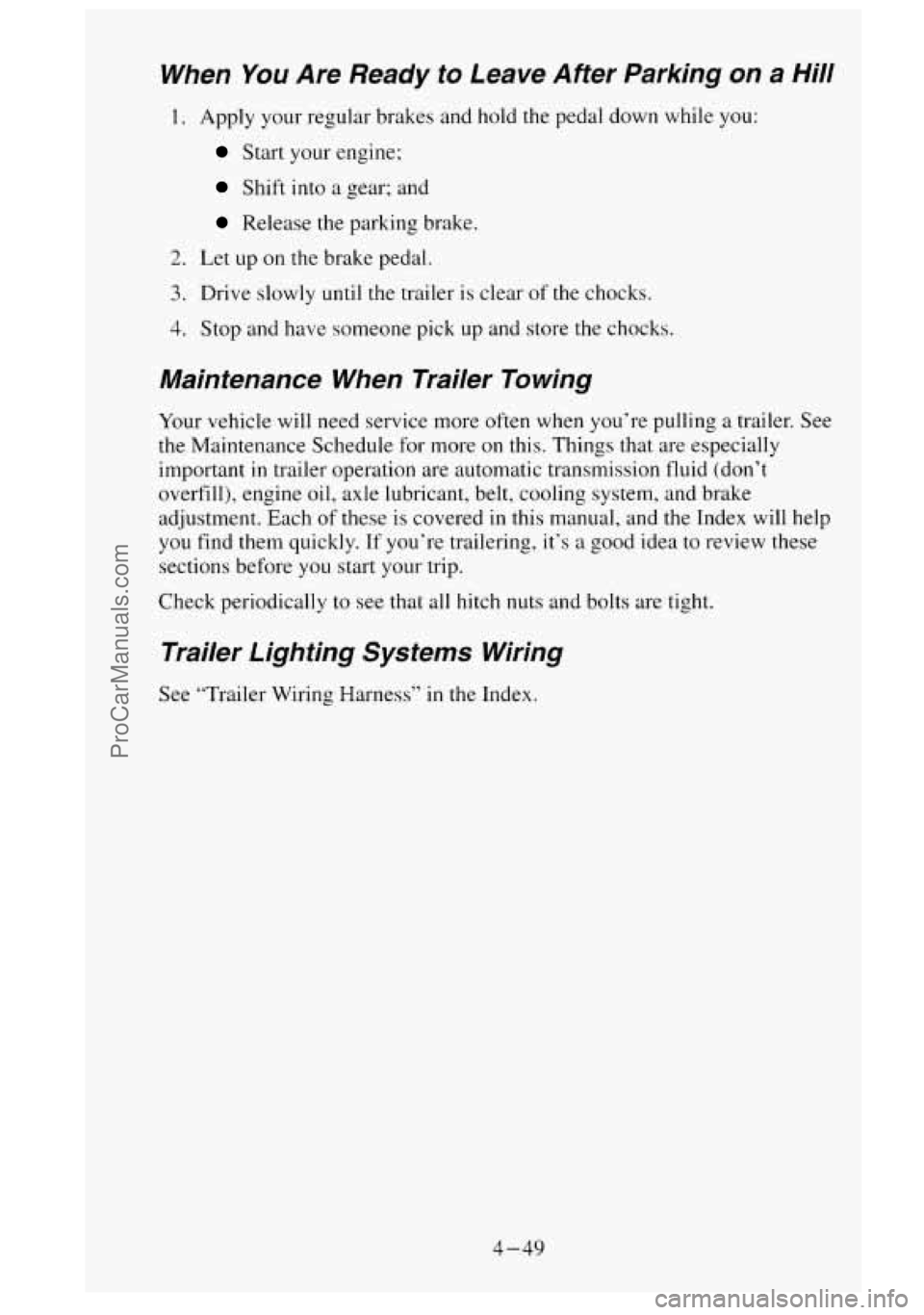
When You Are Ready to Leave After Parking on a Hill
1. Apply your regular brakes and hold the pedal down while you:
Start your engine:
Shift into a gear; and
Release the parking brake.
2. Let up on the brake pedal.
3. Drive slowly until the trailer is clear of the chocks.
4. Stop and have someone pick up and store the chocks.
Maintenance When Trailer Towing
Your vehicle will need service more often when you’re pulling a trailer. See
the Maintenance Schedule
for more on this. Things that are especially
important
in trailer operation are automatic transmission fluid (don’t
overfill), engine oil, axle lubricant, belt, cooling system, and brake
adjustment. Each of these is covered
in this manual, and the Index will help
you find them quickly. If you’re trailering, it’s
a good idea to review these
sections before you start your trip.
Check periodically to see that all hitch
nuts and bolts are tight.
Trailer Lighting Systems Wiring
See “Trailer Wiring Harness” in the Index.
4-49
ProCarManuals.com